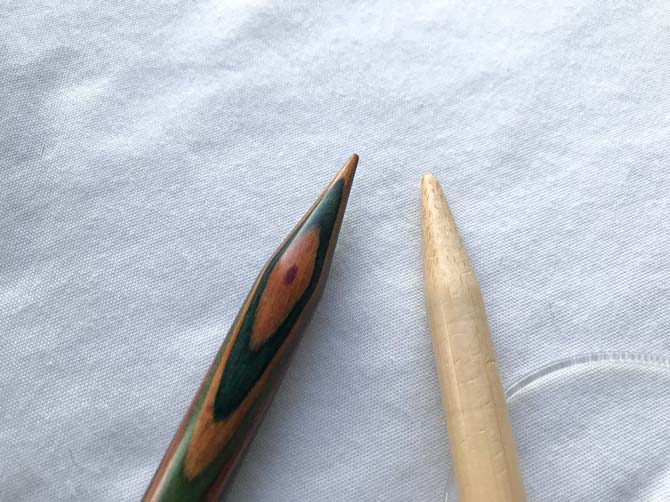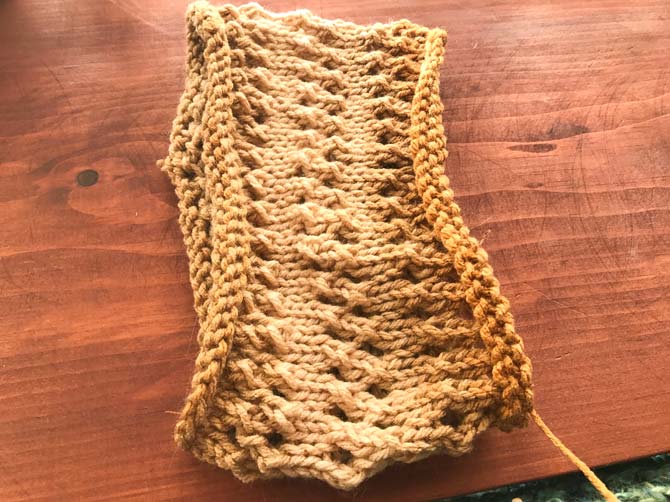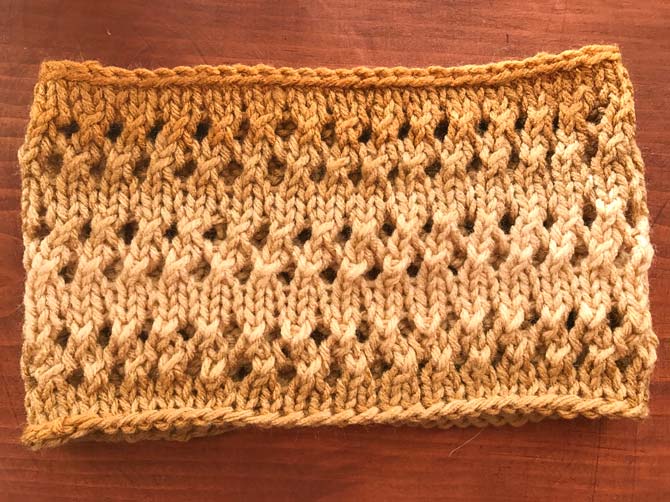Talking about knitting lace patterns in yesterday’s post made me think about a time when lace knitting was a very scary thing for me. I was so intimidated by it that I wouldn’t even try it. While the Cozy Kiddo Poncho from yesterday is a very easy pattern, here are my 10 essential tips to bring success to any lace knitting pattern, whether it’s easy peasey lemon squeezy or difficult difficult orange doesn’t-rhyme-with-anything difficult.
1. Use pointy needles
Whether you’re knitting with a medium yarn like Super Saver Stripes or a very fine lace, sharp needles are going to make something like a P3TOG much easier. Blunt knitting needles are going to feel more cumbersome than sharper ones. There are several kinds of needles specially designed for lace work. Luckily, the points of knitting needles can almost always be seen through the package so we can tell if they’re pointy or blunt.

You see how the needle on the left is much pointier than the needle on the right? These needles are the same size just two different brands. The one on the left is a KnitPicks needle.
2. Go over your legend
You want to know your legend (and abbreviations) inside and out, especially if you’re using a chart. Everything on a chart has a symbol. Be sure you can tell them all apart. Likewise, go over all the abbreviations to make sure you know what the designer is asking you to do. If the designer wrote the pattern for a centered double decrease, and you use a slip, slip, knit, psso, your garment won’t look like the picture in the pattern!
3. Keep track of your chart
Don’t lose your place! You can use post-it notes, washi tape, or those cool little magnet chart keepers to make sure you keep track of what row you were on. If you want a backup, use a row counter, too! Once you get going, you’ll only need these things for more complex patterns, but if you have a hard time remembering a lace pattern, put that bad boy on a magnet board and knit along with pride. Do what works for you.
4. Color code your chart
I had to do a really intense cable pattern (I know! Me? Perhaps this is where my fear of cables spawned.) I made sure to highlight all the different crosses, 3×3, 4×4, 6×6 and if they crossed to the front or the back. You can apply this to lace patterns, too. You can highlight, or color in with pencil crayons, anything that will make you remember that the stitch coming up is an KPSSO and not an SSK.

This is only a small portion of an 8.5″ x 11″ piece of paper and the chart covers the whole thing. This is that cable experience I was talking about. Cables everywhere!!
5. Knit in good lighting
Again, I’m going to say do what works for you. If you never have any problem seeing stitches then I wouldn’t worry too much about this tip. If you need to see how many stitches you’re counting, I’d suggest avoiding needles that are close in color to your yarn. And, please, don’t knit lace in a movie theater!
6. Use stitch markers
Many lace patterns use a repeat of a specified amount of stitches. When the pattern says something to the effect of ‘cast on a multiple of eight,’ that’s a hint that you’re going to be repeating a pattern of eight. Usually the pattern itself will tell you to place stitch markers, but if it doesn’t, take the initiative and place them yourself! It will go a long way towards facilitating a smooth knitting process.

Stitch markers come in all shapes and sizes. There are hundreds of different kinds, so find ones that work with you and are easy to see (or feel).
7. Use a lifeline
Speaking of facilitating a smooth knitting process… if you’re doing something complicated then place life lines in your knitting. Lifelines are threaded through the stitches (and yarn overs) of a row or round that create a place that you can go back to if you make a mistake a few rows further on.
8. The right yarn
This tip goes hand in hand with #5. If you have trouble seeing your yarn you shouldn’t knit with black yarn or really dark yarn. You’re going to have to read your knitting and if you have a hard time telling a knit from a purl on dark yarn, then I recommend that you steer clear of dark yarns and look into brighter colors.

It’s fun to experiment lace work with Super Saver Stripes self-striping yarn.

You will recognize this from yesterday’s post. It is the swatch of Latte Stripes in the Cozy Kiddo Poncho pattern. This is what it looked like before blocking. It’s all curled and bumpy, it doesn’t display the pattern well at all.
9. Blocking can make a world of difference
If you ever read about knitting lace, depending on the pattern, you may have heard that it doesn’t look good while it is on the needles. I remember reading one post where the writer compared the lace shawl she was knitting to ‘something the cat threw up’, BUT once she blocked it, the shawl was beautiful. When you’re contorting all these stitches into different configurations the yarn isn’t going to lay flat.
Think about it from the yarn’s point of view. It’s used to going into stockinette stitch or garter stitch and you add yarn overs and decreases? Of course it’s going to be confused! When you block your garment you’re chaperoning the yarn into its proper place. Everything will relax and lay flat, just how you imagined. Don’t be discouraged if you’re knitting something and it isn’t perfect, the blocking can do magic!

Do you see how the swatch above was transformed by blocking? This was steam blocked — I didn’t even get the whole thing wet and lay it out to dry.
10. Read your knitting
One thing that you should be watching when you’re knitting (especially with charts) is how the stitches line up on top of one another. If your yarn overs are supposed to fall in a diagonal pattern, but they’ve started appearing in perfect vertical rows, something’s wrong. Be mindful of what is happening below the row you’re currently knitting. If you catch it in the moment and check in with your other rows, it can save you from ripping out rows (and hours) of work later on.
Don’t be afraid of lace knitting! Boldly stride right in, carrying these tips and tricks with you. I know I’ve said it before, but the best way to learn something new is to fearlessly fling yourself into the void.
11. Best Tip EVER
Learn as much as you can on your first project and look up every term you don’t understand. Never save something for the time when you’re ‘skilled enough’ — if you do that, when exactly are you going to learn those skills? Learn them while you’re knitting something you love, or grab some scraps from a previous project and play around. Now’s a good time!
This is part 3 of 5 in this series.
Go back to part 2: How to effectively work lace stitches using the Super Saver Stripes yarn
Go to part 4: How self-striping yarn adds pizzazz to a simple lace patterned scarf
[shareaholic app=”follow_buttons” id=”23784471″]
